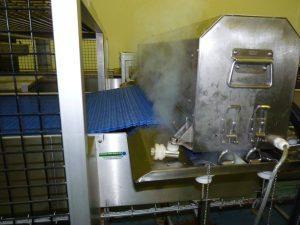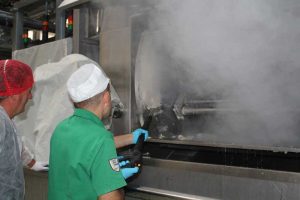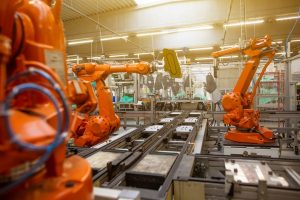Manual conveyor belt cleaning involves the use of handheld tools or equipment to remove dirt and debris from the belt surface. This method offers several advantages, including a high level of control and precision. Workers can target specific areas that require cleaning and ensure thorough removal of contaminants. Additionally, manual cleaning allows for visual inspection of the belt, enabling early detection of any damage or wear.
However, manual conveyor belt cleaning also has its drawbacks. Firstly, it can be a labor-intensive process, requiring dedicated personnel to perform the cleaning tasks regularly. This can result in increased labor costs for the facility. Moreover, manual cleaning may not be as efficient as automated methods, as it relies on the physical effort of workers. There is also a risk of injury or accidents during manual cleaning if proper safety precautions are not followed.
Automatic Conveyor Belt Cleaning: Pros and Cons
Automatic conveyor belt cleaning involves the use of specialized equipment that is designed to clean the belts automatically without the need for manual intervention. This method offers several advantages over manual cleaning. Firstly, it is highly efficient and can clean large areas of the belt quickly and effectively. This can help reduce downtime and increase productivity in industries where continuous operations are critical.
Another significant advantage of automatic conveyor belt cleaning is the potential reduction in labor costs. Once the equipment is installed and set up, it can operate autonomously without requiring dedicated personnel for cleaning tasks. This can result in significant cost savings for the facility in the long run. Additionally, automatic cleaning methods can be programmed to clean the belts at regular intervals, ensuring consistent cleanliness and reducing the risk of contaminants building up.
However, there are also potential disadvantages to automatic conveyor belt cleaning. One of the main concerns is the initial investment cost. The specialized equipment required for automatic cleaning can be expensive, and facilities need to consider the return on investment before implementing this method. Additionally, automatic cleaning methods may require regular maintenance and servicing to ensure optimal performance. Failure to maintain the equipment properly can lead to breakdowns and increased downtime.
Comparison of Manual and Automatic Conveyor Belt Cleaning
When comparing manual and automatic conveyor belt cleaning methods, several key differences emerge. In terms of cost, manual cleaning may have lower upfront costs as it does not require specialized equipment. However, over time, manual cleaning can result in higher labor costs due to the need for dedicated personnel. On the other hand, automatic cleaning methods may have higher initial investment costs but can lead to significant long-term savings in labor costs.
In terms of efficiency, automatic cleaning methods are generally more efficient than manual cleaning. They can clean large areas of the belt quickly and effectively, reducing downtime and increasing productivity. Manual cleaning, on the other hand, may be slower and less efficient, especially for larger conveyor systems.
Safety is another important consideration when comparing the two methods. Manual cleaning poses a higher risk of injury or accidents if proper safety precautions are not followed. Automatic cleaning methods eliminate or reduce the need for workers to be in close proximity to moving parts of the conveyor system, improving overall safety.
Maintenance requirements also differ between manual and automatic cleaning methods. Manual cleaning may require less maintenance as it does not involve specialized equipment. However, regular inspections and servicing are still necessary to ensure safe and effective operations. Automatic cleaning methods may require more frequent maintenance and servicing to ensure optimal performance and prevent breakdowns.
Benefits of Steam Vapour Cleaning Machines
| Comparison of Manual and Automatic Conveyor Belt Cleaning | Manual Cleaning | Automatic Cleaning |
|---|---|---|
| Labour Cost | High | Low |
| Time Required | Long | Short |
| Cleaning Efficiency | Low | High |
| Equipment Cost | Low | High |
| Maintenance Cost | Low | High |
Steam vapour cleaning machines offer several benefits for conveyor belt cleaning. These machines use high-temperature steam and pressure to remove dirt, grime, and contaminants from the belt surface. One of the main advantages of steam vapour cleaning is its ability to remove stubborn dirt and grime that may be difficult to remove with other cleaning methods. The high-temperature steam can penetrate deep into the belt surface, loosening and dissolving dirt particles for easy removal.
Another significant benefit of steam vapour cleaning machines is their ability to sanitize surfaces. The high-temperature steam can kill bacteria, viruses, and other pathogens, ensuring a clean and hygienic conveyor belt. This is particularly important in industries where food safety is a concern, such as the food processing industry.
Additionally, steam vapour cleaning machines can help reduce water usage compared to traditional cleaning methods. The use of steam eliminates the need for excessive water consumption, making it an environmentally friendly option. This can also result in cost savings for the facility by reducing water consumption and wastewater disposal.
How Steam Vapour Cleaning Machines Work
Steam vapour cleaning machines work by heating water to a high temperature to produce steam. The steam is then released through a nozzle or brush attachment, which is used to direct the steam onto the conveyor belt surface. The high-temperature steam softens and loosens dirt, grime, and contaminants, making them easier to remove.
The pressure of the steam also helps dislodge stubborn dirt particles from the belt surface. The steam vapour cleaning machine may also have a vacuum function that simultaneously removes the loosened dirt and moisture from the belt surface. This ensures a thorough and efficient cleaning process.
The high-temperature steam produced by these machines also has sanitizing properties. It can kill bacteria, viruses, and other pathogens on contact, making it an effective method for maintaining a clean and hygienic conveyor belt surface.
Advantages of Automatic Conveyor Belt Steam Vacuum

Automatic conveyor belt steam vacuum systems offer several advantages for conveyor belt cleaning. Firstly, they provide a highly efficient and effective cleaning method. The combination of high-temperature steam and vacuum suction ensures thorough removal of dirt, grime, and contaminants from the belt surface. This can help improve overall cleanliness and reduce the risk of product contamination in industries where hygiene is critical.
Another significant advantage of automatic conveyor belt steam vacuum systems is the potential for reduced labor costs. Once the system is set up and programmed, it can operate autonomously without requiring dedicated personnel for cleaning tasks. This can result in significant cost savings for the facility, especially in industries with large conveyor systems that require frequent cleaning.
Additionally, automatic conveyor belt steam vacuum systems can improve overall safety in the facility. Workers do not need to be in close proximity to moving parts of the conveyor system during cleaning, reducing the risk of accidents or injuries. The automated nature of these systems also ensures consistent cleaning and reduces the risk of human error.
Disadvantages of Automatic Conveyor Belt Steam Vacuum
While automatic conveyor belt steam vacuum systems offer several advantages, there are also potential disadvantages to consider. One of the main concerns is the initial investment cost. These systems can be expensive to purchase and install, requiring a significant upfront investment. Facilities need to carefully evaluate the return on investment before implementing this method.
Maintenance requirements are another potential disadvantage of automatic conveyor belt steam vacuum systems. These systems may require regular servicing and maintenance to ensure optimal performance. Failure to maintain the equipment properly can lead to breakdowns and increased downtime.
There is also a potential safety hazard associated with steam vapour cleaning machines if not used correctly. The high-temperature steam can cause burns or scalds if it comes into contact with skin. Therefore, proper training and safety protocols should be in place to ensure the safe operation of these machines.
Cost Comparison of Manual and Automatic Conveyor Belt Cleaning
When comparing the costs of manual and automatic conveyor belt cleaning, several factors need to be considered. Firstly, manual cleaning may have lower upfront costs as it does not require specialized equipment. However, over time, manual cleaning can result in higher labor costs due to the need for dedicated personnel. Facilities need to consider the cost of labor and the frequency of cleaning tasks to determine the long-term cost implications.
On the other hand, automatic conveyor belt cleaning methods may have higher initial investment costs due to the specialized equipment required. However, these systems can lead to significant long-term savings in labor costs. Facilities need to evaluate the potential labor savings and compare them to the upfront investment cost to determine the overall cost-effectiveness of automatic cleaning methods.
Maintenance costs should also be considered when comparing manual and automatic cleaning methods. Manual cleaning may require less maintenance as it does not involve specialized equipment. However, regular inspections and servicing are still necessary to ensure safe and effective operations. Automatic cleaning methods may require more frequent maintenance and servicing, which can add to the overall cost.
Choosing the Best Conveyor Belt Cleaning Method
In conclusion, choosing the best conveyor belt cleaning method depends on the specific needs and requirements of the industry and facility. Manual cleaning offers a high level of control and precision but can be labor-intensive and less efficient. Automatic cleaning methods offer increased efficiency, reduced labor costs, and improved safety but may require a higher initial investment and regular maintenance.
Steam vapour cleaning machines provide several benefits for conveyor belt cleaning, including their ability to remove stubborn dirt and grime, sanitize surfaces, and reduce water usage. Automatic conveyor belt steam vacuum systems offer even greater efficiency and cost savings by combining high-temperature steam with vacuum suction.
Facilities need to carefully evaluate their needs, budget, and priorities when choosing a conveyor belt cleaning method. It is essential to consider factors such as cost, efficiency, safety, and maintenance requirements to make an informed decision. By selecting the most suitable cleaning method, facilities can ensure the optimal performance and safety of their conveyor belts.
FAQs
What is a conveyor belt cleaning method?
A conveyor belt cleaning method refers to the process of removing unwanted materials such as dirt, debris, and other contaminants from the surface of a conveyor belt.
What are the benefits of cleaning a conveyor belt?
Cleaning a conveyor belt helps to maintain the hygiene and safety of the workplace, prevent product contamination, reduce wear and tear on the belt, and improve the efficiency of the conveyor system.
What are the manual conveyor belt cleaning methods?
Manual conveyor belt cleaning methods include using a scraper, brush, or pressure washer to remove debris and contaminants from the surface of the belt.
What are the automatic conveyor belt cleaning methods?
Automatic conveyor belt cleaning methods include using a belt scraper, belt brush, or belt washer that is attached to the conveyor system and operates automatically to remove debris and contaminants from the surface of the belt.
What are the advantages of manual conveyor belt cleaning?
Manual conveyor belt cleaning is cost-effective, easy to implement, and requires minimal maintenance. It is also suitable for small conveyor systems and can be done by a single operator.
What are the disadvantages of manual conveyor belt cleaning?
Manual conveyor belt cleaning is time-consuming, labor-intensive, and can be dangerous for the operator. It is also less effective than automatic cleaning methods and may not be suitable for large conveyor systems.
What are the advantages of automatic conveyor belt cleaning?
Automatic conveyor belt cleaning is more effective than manual cleaning methods, requires less labor, and is suitable for large conveyor systems. It also improves the efficiency of the conveyor system and reduces wear and tear on the belt.
What are the disadvantages of automatic conveyor belt cleaning?
Automatic conveyor belt cleaning is more expensive than manual cleaning methods, requires more maintenance, and may not be suitable for small conveyor systems. It also requires a power source to operate.










